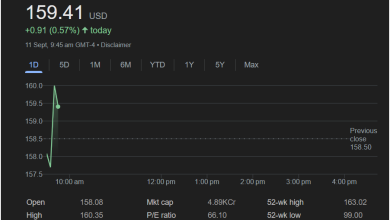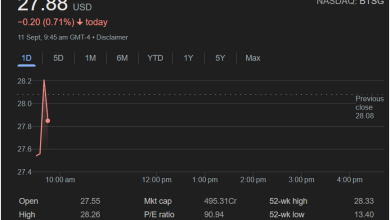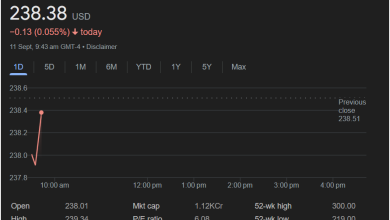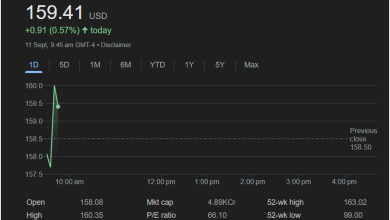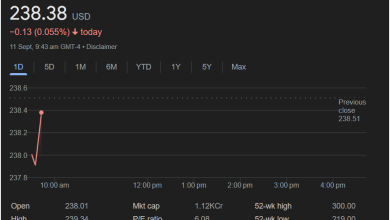Palantir Technologies Inc. (PLTR): A Deep Dive into its Market Performance and Future Prospects
A Glimpse into Palantir's Recent Market Activity

Palantir Technologies Inc. (PLTR) has been a company that consistently draws attention, both from investors and the broader tech community. Known for its sophisticated data analytics platforms, Palantir’s market performance is often a subject of intense scrutiny. As of the close on September 5th, the stock was trading at 153.11 USD, reflecting a daily decrease of 3.03 USD, or 1.94%. After hours, the stock saw a further slight dip, closing at 152.30 USD, down 0.81 USD (0.53%) from its market close. This snapshot, while immediate, is just one piece of a much larger and more complex puzzle.
The provided chart illustrates the intraday performance of PLTR, painting a picture of volatility within a single trading day. Starting the day with an open at 157.82 USD and reaching a high of 158.97 USD, the stock experienced a significant drop in the morning, hitting a low of 148.04 USD before recovering some of its losses in the afternoon. This kind of fluctuation is not uncommon in the tech sector, particularly for companies like Palantir that operate in rapidly evolving and sometimes politically sensitive domains. The previous close was 156.14 USD, indicating that the day’s trading pushed the stock below its prior valuation.
Beyond the daily movements, other key metrics provide a broader context for Palantir’s current standing. The company boasts a substantial Market Cap of 36.31KCr, highlighting its significant presence in the market. Its P/E ratio stands at a remarkable 508.81, a figure that often sparks debate among analysts. A high P/E ratio can suggest that investors have high expectations for future earnings growth, but it can also raise questions about whether the stock is overvalued. In Palantir’s case, this figure is a testament to the market’s belief in its long-term potential, despite current profitability metrics.
Looking at the longer-term perspective, Palantir’s 52-week high was 189.46 USD, and its 52-week low was 29.50 USD. This wide range underscores the stock’s significant price swings over the past year, reflecting various market sentiments, company announcements, and broader economic factors. The journey from its 52-week low to its current price point indicates substantial growth, captivating many investors.
Interestingly, Palantir currently shows no dividend yield (Div yield –), nor any quarterly dividend amount (Qtrly div amt –). This is typical for many growth-oriented tech companies that choose to reinvest their earnings back into the business for expansion and innovation, rather than distributing them to shareholders as dividends. This strategy is often favored by investors who prioritize capital appreciation over regular income.
The Business of Palantir: Data, Defense, and Beyond
To truly understand Palantir’s market dynamics, one must delve into its core business. Founded in 2003, Palantir Technologies is a software company specializing in big data analytics. It offers two main platforms: Palantir Gotham and Palantir Foundry.
Palantir Gotham is primarily used by government agencies, particularly in the defense and intelligence sectors. It helps analysts integrate and visualize large datasets, enabling them to identify patterns, track activities, and make informed decisions in areas like counterterrorism, fraud detection, and cybersecurity. The company’s deep ties to government contracts have been both a source of its strength and, at times, controversy, sparking debates about privacy and ethics.
Palantir Foundry, on the other hand, is designed for commercial enterprises. It helps businesses integrate their data, build operational applications, and make data-driven decisions across various functions, from supply chain optimization to pharmaceutical research. The company has been increasingly focusing on expanding its commercial client base, a strategic move to diversify its revenue streams and reduce its reliance on government contracts.
Palantir’s technology is often described as complex and powerful, capable of tackling some of the most challenging data problems. Its platforms are not off-the-shelf solutions but rather highly customized and integrated systems that require significant expertise to implement and manage. This bespoke approach often leads to high-value contracts and strong customer relationships, but it can also limit scalability compared to more standardized software offerings.
The company’s mission, as articulated by its founders, is to make the world’s data useful. This ambitious goal involves not just collecting and processing data but also providing the tools and insights necessary for users to derive actionable intelligence. In an age where data is often called the new oil, Palantir positions itself as a crucial enabler for organizations seeking to harness its full potential.
Factors Influencing Palantir’s Market Performance
Several factors continuously influence Palantir’s stock performance. Understanding these elements is crucial for anyone attempting to gauge the company’s future trajectory.
Government Contracts and Geopolitical Landscape
Given Palantir’s significant involvement with government agencies, particularly in the U.S. and its allies, geopolitical events and defense spending policies directly impact its revenue and investor sentiment. Wars, conflicts, or increased focus on national security often translate into higher demand for Palantir’s Gotham platform. Conversely, shifts in government priorities or budget cuts could pose challenges. The political climate surrounding data privacy and surveillance also plays a role, as increased scrutiny could lead to stricter regulations or public backlash, potentially affecting Palantir’s ability to secure new contracts.
Commercial Expansion and Diversification
Palantir’s efforts to expand its commercial footprint are a critical driver of its long-term growth story. Success in attracting and retaining large enterprise clients for its Foundry platform is closely watched by investors. The company’s ability to demonstrate the value of its software to diverse industries—from manufacturing to healthcare—will be key to diversifying its revenue streams and proving its broader market applicability. Any major contract wins or losses in the commercial sector can significantly sway investor confidence.
Innovation and Technological Edge
In the fast-paced world of technology, continuous innovation is paramount. Palantir’s ability to maintain its technological edge in big data analytics, artificial intelligence, and machine learning is crucial. The introduction of new features, improvements in platform scalability, and advancements in data integration capabilities can all contribute to its competitive advantage. Conversely, if competitors emerge with more advanced or cost-effective solutions, Palantir could face increased pressure.
Profitability and Financial Performance
While Palantir has seen significant revenue growth, its path to consistent profitability has been a point of contention for some investors, as reflected in its high P/E ratio. The company has historically invested heavily in research and development and sales and marketing to fuel its growth. Demonstrating a clear path to sustainable profitability and positive free cash flow will be essential to satisfy a broader range of investors, particularly those seeking more established, profitable companies. Quarterly earnings reports, revenue guidance, and profitability metrics are closely scrutinized as indicators of its financial health.
Market Sentiment and Macroeconomic Factors
Like all publicly traded companies, Palantir is also subject to broader market sentiment and macroeconomic conditions. Factors such as interest rate changes, inflation, economic recessions, or shifts in investor appetite for growth stocks can all impact its stock price, regardless of company-specific news. The overall health of the technology sector and investor confidence in high-growth, high-valuation companies can also play a significant role.
Competitive Landscape
The big data analytics market is highly competitive, with a mix of established tech giants and nimble startups vying for market share. Palantir competes with companies offering various data management, analytics, and AI solutions. Its unique selling proposition lies in its highly integrated and customized platforms designed for complex, sensitive data environments. However, competitors are constantly evolving, and Palantir must continuously innovate and differentiate itself to maintain its leadership position.
The Future of Palantir: Opportunities and Challenges
Looking ahead, Palantir faces both significant opportunities and formidable challenges that will shape its future trajectory.
Opportunities for Growth
Expanding Commercial Sector: The most significant opportunity for Palantir lies in its continued expansion into the commercial market. The vast majority of companies across all industries are grappling with how to effectively manage and leverage their data. Palantir’s Foundry platform, with its ability to integrate disparate data sources and create actionable insights, is well-positioned to address this widespread need. Successful expansion in this area could significantly diversify its revenue base and reduce its reliance on government contracts.
Artificial Intelligence and Machine Learning: As AI and machine learning continue to evolve, Palantir’s platforms are at the forefront of this technological revolution. Its ability to incorporate advanced AI capabilities into its data analytics solutions will be crucial for maintaining its competitive edge. The increasing demand for AI-driven insights across various sectors presents a massive growth opportunity for the company.
Strategic Partnerships and Acquisitions: Palantir could pursue strategic partnerships or acquisitions to expand its market reach, enhance its technological capabilities, or enter new industry verticals. Collaborating with other tech companies or acquiring smaller, innovative startups could accelerate its growth and strengthen its competitive position.
International Expansion: While Palantir has a global presence, there’s still ample room for international expansion, particularly in commercial markets outside of its core government intelligence sectors. As more countries and businesses globally recognize the value of data-driven decision-making, Palantir could find new avenues for growth.
Cloud Integration: Further integrating its platforms with major cloud providers could enhance accessibility and scalability for its clients, making it easier for businesses to adopt and deploy Palantir’s solutions.
Challenges on the Horizon
Data Privacy and Ethical Concerns: Palantir’s work, particularly with government agencies, often raises concerns about data privacy, surveillance, and ethical implications. As public awareness and regulatory scrutiny around data usage increase, the company will need to navigate these issues carefully. Any perceived missteps could lead to reputational damage and impact its ability to secure new contracts.
Competition: The data analytics and AI market is highly competitive. Palantir faces competition from established tech giants like IBM, Oracle, and Microsoft, as well as a plethora of specialized data analytics and AI startups. Maintaining its differentiation and continually innovating will be crucial to fend off competitors.
Scalability and Customization: While Palantir’s highly customized solutions are a strength for large, complex organizations, they can also be a challenge for broader scalability. The time and resources required for implementation and ongoing support can be significant, potentially limiting its ability to serve a wider range of smaller or medium-sized businesses without significant adjustments to its business model.
Talent Acquisition and Retention: The demand for skilled professionals in data science, AI, and software engineering is intense. Palantir will need to continuously attract and retain top talent to maintain its innovative edge and deliver on its ambitious projects.
Economic Downturns: As with any company, an economic downturn could lead to reduced spending by both government and commercial clients, impacting Palantir’s revenue growth. Companies might defer large software investments during periods of economic uncertainty.
Regulatory Environment: The evolving regulatory landscape around data governance, artificial intelligence, and cybersecurity could present compliance challenges and potentially impact Palantir’s product development and market access.
The Investor’s Perspective: Valuing Palantir
For investors, valuing Palantir remains a complex exercise. Its high P/E ratio suggests that the market is assigning a significant premium to its future growth potential. This often means that even small disappointments in earnings or guidance can lead to substantial stock price corrections.
Growth investors are typically attracted to Palantir’s innovative technology, its strong position in critical government sectors, and its potential for commercial expansion. They are often willing to tolerate lower current profitability in exchange for the promise of high future returns.
However, value investors might find its current valuation challenging, looking for companies with more established profitability and lower P/E ratios. They might argue that much of Palantir’s future growth is already priced into the stock.
Key metrics that investors will continue to watch include:
-
Revenue Growth: The pace at which Palantir is expanding its top line, particularly in the commercial sector.
-
Customer Acquisition: The number of new commercial clients and the growth in average revenue per customer.
-
Profitability Metrics: Progress towards sustainable profitability and positive free cash flow.
-
Gross Margins: The efficiency with which the company generates revenue relative to its cost of goods sold.
-
Operating Expenses: How effectively Palantir manages its operating costs while continuing to invest in growth.
-
Backlog and Contract Wins: Indicators of future revenue potential, especially from long-term contracts.
The long-term success of Palantir will likely hinge on its ability to execute its commercial expansion strategy effectively, continue to innovate its core platforms, and navigate the complex ethical and regulatory landscape surrounding big data and AI. Its journey has been marked by significant milestones and challenges, and its future promises to be just as dynamic.
The Human Element: Palantir’s Impact and Perception
Beyond the financial metrics and technological prowess, Palantir’s story is also deeply intertwined with its human impact and public perception. The company’s work, especially with intelligence agencies, has often placed it at the center of debates about surveillance, privacy, and the role of technology in society.
On one hand, proponents argue that Palantir’s tools are vital for national security, helping to prevent terrorist attacks, combat fraud, and save lives. They emphasize the power of data to uncover critical insights that would otherwise remain hidden, enabling governments and organizations to make better, more informed decisions in high-stakes environments. The ability to connect disparate data points from various sources – whether it’s financial transactions, communication records, or satellite imagery – and present them in an understandable format can be incredibly powerful in the fight against crime and terrorism.
On the other hand, critics express deep concerns about the potential for misuse of such powerful technology. The aggregation and analysis of vast amounts of personal data, even when anonymized or used for legitimate purposes, raise questions about civil liberties, the potential for algorithmic bias, and the concentration of power in the hands of a few. The “black box” nature of some advanced AI systems used by Palantir’s platforms further fuels these concerns, as it can be difficult to understand how certain decisions or recommendations are reached, making accountability challenging.
The company’s approach to these issues has also evolved. While historically maintaining a somewhat secretive profile, Palantir has become more vocal about its ethical frameworks and its commitment to responsible technology use. However, the inherent nature of its work means that these debates will likely continue to follow the company. Public perception, therefore, is not just a matter of branding; it can directly impact its ability to secure new contracts, attract talent, and maintain a social license to operate.
For employees, working at Palantir can be a unique experience. The company often attracts highly skilled individuals who are passionate about solving complex problems. The culture is frequently described as intense, intellectually stimulating, and mission-driven. However, the demanding nature of the work and the often-controversial aspects of its clients can also be sources of stress or ethical dilemmas for some. The ability to work on projects that have a significant, real-world impact – from humanitarian aid to national defense – can be a powerful motivator, but it also comes with a heavy responsibility.
Moreover, the narrative surrounding Palantir is often shaped by its charismatic co-founder, Peter Thiel, whose libertarian views and strong opinions on technology and society often draw significant media attention. His influence on the company’s philosophy and strategic direction is undeniable, further adding layers of complexity to how the company is perceived.
The Broader Ecosystem: Palantir’s Role in the Data Economy
Palantir operates within a rapidly expanding and increasingly critical data economy. Its contributions extend beyond just its direct clients, influencing the broader technological landscape.
Catalyst for Data Modernization: By offering advanced data integration and analytics platforms, Palantir acts as a catalyst for data modernization within organizations. Many governments and large enterprises are still struggling with siloed data, legacy systems, and inefficient data management practices. Palantir’s solutions help them overcome these challenges, enabling a more data-driven approach to their operations. This, in turn, can inspire other organizations to invest in similar data infrastructure.
Driving AI Adoption: As a company deeply embedded in AI and machine learning, Palantir plays a role in driving the adoption and maturation of these technologies. Its successful deployment of AI in complex, real-world scenarios demonstrates the practical utility and transformative potential of a
